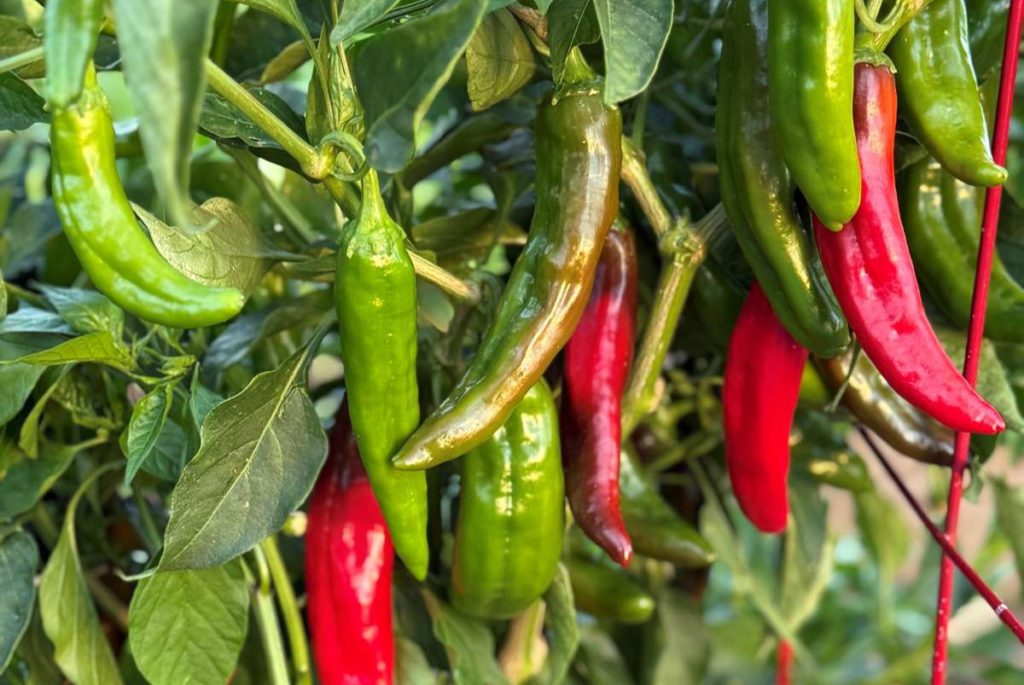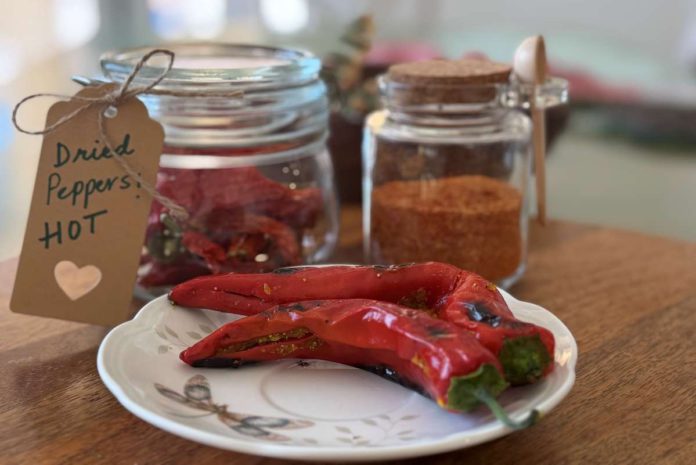Peppers are members of the nightshade (Solanaceae) family, which also includes eggplants, potatoes and tomatoes. They present in a wide variety of sizes, colors and shapes, but generally fall into two categories based on heat content. Peppers without heat are also known as sweet peppers and include bell peppers. Some examples of milder sweet peppers are banana, pimentos and sweet Italian peppers.
Chilies peppers pack heat and range from mild to very hot. Sometimes the word peppers is used interchangeably with chilies to refer to hot peppers. They tend to be longer, thinner and more tapered than sweet peppers. Recommended hot varieties to grow in California include anaheim, carolina reaper, cayenne, fresno, ghost (bhut jalokia), habanero, jalapeño and serrano.
Fun fact, the term ghost pepper appears to be a mistranslation of the original name that contains the term “bhut” (/bʱʊt/) which is a reference to “Bhutanese” but has a near homonym “bhut” /bʱut/ that means ghost. Pepper heat is measured in Scoville Heat Units (SHU), invented by William Scoville in 1912. It measures the concentration of a chemical called capsaicin which determines the sensation of the heat.
If you desire to plant less-available varieties, it is best to purchase seeds and start them indoors eight to 10 weeks in advance of planting. When starting with seeds, I like to use a new starting mix to fill up the cell trays. I prefer using trays and pots that have a dome to create humidity for the germinating seeds.
If you plan to reuse trays or pots, clean them with soap and warm water to remove dirt and allow them to sit in a 10% bleach solution for ten minutes. Once dry, fill up the pots with the premoistened mix. Add two seeds per cell and use a heating mat to keep soil temperature around 75 to 85 ºF for good germination. Water regularly, but know overwatering can cause seeds to rot. Once seeds germinate, move them from the heating mat to a sunny location like a windowsill.

Once peppers are ready to be moved outdoors, they can be planted in containers or in the ground. I like to plant them outside when the daytime temperature is consistently above 75 ºF. For me that coincides with planting tomatoes in mid May. Space peppers 18 to 24 inches apart in rows or blocks in a sunny spot with well-draining soil that has a lot of organic matter, and plant them a bit deeper to encourage additional root growth for sturdiness.
Just like tomatoes, peppers develop roots from the stem that is buried under the ground, helping anchor. Once plants have established, I give them a side dressing of vegetable fertilizer to encourage flower and fruit growth. In my experience, carolina reaper, ghost and habanero peppers start growing later in the season and benefit from longer periods of hotter weather. The plants also tend to be bigger.
I take off a few of the bottom leaves that have started to touch the soil to encourage air flow and to avoid any pests crawling up. I also take off early flowers and first few fruits to give plants a chance to grow stronger. While peppers thrive in hot temperatures, long periods of hot, dry conditions can sometimes cause scalding on the fruit, especially bell peppers. When I see this, I try to cover the plants with row covers in the afternoon.
Peppers are ready to harvest when they have reached their mature size and color. Being gentle is the key to picking peppers without damaging the plant. Use a clean, sharp pruner to cut instead of tugging them. When working with hot peppers, wear rubber gloves, eye protection and a face mask.
I like to dry hot peppers like cayenne and red hot Thai chilli that can be stored for a longer time. They can be sun or air dried if the outside temperature is consistently above 85 ºF. I take advantage of the heat waves and low humidity days to dry peppers. They can be left in the sun during the day, and brought indoors during cooler nighttime temperatures.
Smaller Thai peppers can be dried whole or with a slit, and larger ones can be cut in halves to hasten the process. They will be completely dried when they’re brittle, after five to seven days. Then they can be stored in a jar in a cool dry place. Dried peppers can be used to make pepper flakes, powder or can be soaked in warm water to be rehydrated. Fresh peppers can be used in sautéing, pastes, soups and stir-fry.
In some cultures, another use of red chilies is to hang them in doorways to ward off the evil eye and envious glances.
Stuffed chili peppers with raw mango:
Anaheim chilies – six to eight that are four to five inches long. Can substitute with Fresno.
Raw tart mango – 250g, grated or finely chopped
Garlic cloves – six to eight, roughly chopped
Oil for cooking – three tablespoons
Salt to taste
Wash and pat dry peppers. Make a slit along the concave side of the pepper, taking care not to go all the way through to the other side, and hollow out any seeds or membranes. Wash and peel mango and grate using the largest shredding holes. Heat up a tablespoon of oil in a pan and sauté garlic until it turns fragrant and slightly golden, typically one minute. Add the grated mango; sautéing allows for any moisture to dry away from the mango.
Add spices as desired. My personal favorite is to add fennel seed powder and a bit of sugar. Add dried red chili powder to further raise the heat, if needed. Add salt. When cool, run ingredients through a blender. If the mixture appears drier, add a couple of teaspoons of water. Fill the cavity of the pepper with the mixture.
In a pan, warm up the other two tablespoons of oil and gently lay in the stuffed peppers. Cook on medium heat until the skins appear soft. Turn peppers over, reduce the heat to low and cover with a lid to cook until done. These can be enjoyed as a side dish or can be added to a sandwich or a burger. My personal favorite is to wrap it up in a flat bread along with fresh onions, tomatoes and cucumbers and dip in mint chutney.
Among many recipes that my mother has taught me, the very best are the ones that have taught me patience, practice and purpose, and most importantly the ones that have added spice to life!
Note: This article gives an overview of growing plants, sun and soil requirements, moisture needs etc. Plant health and growth will vary based on various factors. This article is intended for gardening and culinary inspiration only. Please consult your healthcare provider should you have any questions or concerns about adding any new foods or ingredients to your diet.




